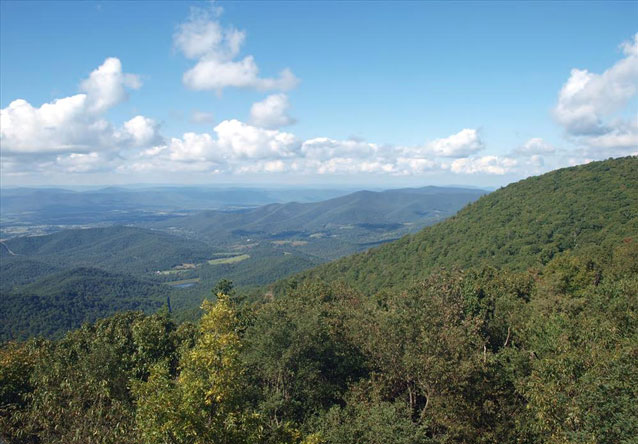An Amazing View and Important Message at Shenandoah NP

NPS photo
Breathtaking views, vibrant fall foliage, and cool, clean air entice hundreds of thousands of East Coast residents to take a day’s drive to visit Shenandoah National Park each autumn. And on Oct. 6, 2016, park staff welcomed two special guests for a hike up Hawksbill Mountain: Secretary of the Interior Sally Jewell and Environmental Protection Agency (EPA) Administrator Gina McCarthy.
Jewell and McCarthy used the trip to Virginia’s picturesque Shenandoah as an opportunity to highlight the National Park Service (NPS) and EPA commitment to clean air, clear views, and dark skies for us and our future generations. Shenandoah is an amazing natural retreat where bears, deer, and native fish thrive among the forests and streams. The iconic Skyline Drive offers vistas from the Blue Ridge mountains into the Shenandoah Valley and Piedmont below. However, like many other parks, Shenandoah faces significant environmental challenges due to the realities of air pollution and climate change.
Work to reduce air pollution
Clean air is essential for human life and for healthy ecosystems. Clean air is also crucial for the scenic views enjoyed in national parks. In fact, Shenandoah was established as a national park due in part to the amazing views from summits like Old Rag and Stony Man Mountains, but the park has had to deal with impacts of air pollution for decades.
High levels of sulfur and nitrogen deposition (acid rain) have damaged park streams, and some are no longer able to support native trout populations. Sulfur deposition has decreased over the past decade, however the rate of nitrogen deposition, has remained relatively unchanged. Air pollution also scatters and absorbs light creating a haze that can obscure distant objects and mute the color and detail in a view. Fortunately, the haze problem in the United States is getting better, largely because of pollution reductions under the Regional Haze Rule of the Clean Air Act. Now at Shenandoah National Park you can typically see over 63 miles, which is 30 miles better than a visitor would have seen in the early 1990s. But research suggests that without any air pollution you would be able to see 121 miles on an average day—so we have a long way to go.
You can check in on the visibility, weather, and current air quality at the park from your own home or office, any time, on the Shenandoah Air Quality WebCam. Or, learn about the air quality at Shenandoah NP and what more than 30 years worth of monitoring data reveal about park air quality conditions and trends.
Effects of climate change in national parks
On Oct. 6, 2016, Ecosphere published a paper that shows spring is arriving earlier in many national parks. In fact, in 3 out 4 parks studied, the dates of the first blooms and leaves of honeysuckle and lilac—so-called Spring Indices—are occurring earlier than historical averages.
Climate change is not a worry of the future; it’s already affecting national parks.
Among other consequences of early spring onset, it interferes with relationships between flowers and pollinators, and the earlier warm temperatures give invasive plant species the opportunity to displace native plants. At Shenandoah, park staff have identified 360 non-native plants, including 41 highly destructive plants, like garlic mustard and oriental bittersweet. Additionally, warming temperatures affect the lifecycles of native brook trout that require cool water.
Take home message
As they took in the scenic views, Jewell and McCarthy noted that significant air quality and climate change challenges are a reality—even for parks and wilderness areas with the highest levels of protection under the law. We can make progress toward the goals of clean air and healthy ecosystems through continued research and flexibility in managing these landscapes in a changing climate. Special places like Shenandoah make it well worth the effort.
Last updated: March 14, 2018
